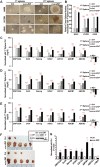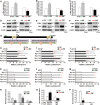Oncogenic zinc finger protein ZNF322A promotes stem cell-like properties in lung cancer through transcriptional suppression of c-Myc expression
- PMID: 30258097
- PMCID: PMC6748145
- DOI: 10.1038/s41418-018-0204-6
Oncogenic zinc finger protein ZNF322A promotes stem cell-like properties in lung cancer through transcriptional suppression of c-Myc expression
Abstract
ZNF322A, a C2H2 zinc finger transcription factor, is an oncoprotein in lung cancer. However, the transcription mechanisms of ZNF322A in lung cancer stem cell-like reprogramming remain elusive. By integrating our chromatin immunoprecipitation-sequencing and RNA-sequencing datasets, we identified and validated the transcriptional targets of ZNF322A, which were significantly enriched in tumorigenic functions and developmental processes. Indeed, overexpression of ZNF322A promoted self-renewal ability and increased stemness-related gene expressions in vitro and in vivo. Importantly, ZNF322A bound directly to c-Myc promoter and recruited histone deacetylase 3 to transcriptionally suppress c-Myc expression, which in turn increased mitochondrial oxidative phosphorylation and promoted cell motility, thus maintaining stem cell-like properties of lung cancer. Clinically, ZNF322AHigh/c-MycLow expression profile was revealed as an independent indicator of poor prognosis in lung cancer patients. Our study provides the first evidence that ZNF322A-centered transcriptome promotes lung tumorigenesis and ZNF322A acts as a transcription suppressor of c-Myc to maintain lung cancer stem cell-like properties by shifting metabolism towards oxidative phosphorylation.
Conflict of interest statement
The authors declare that they have no conflict of interest.
Figures







References
Publication types
MeSH terms
Substances
LinkOut - more resources
Full Text Sources
Other Literature Sources
Medical
Molecular Biology Databases

